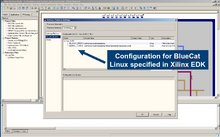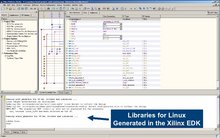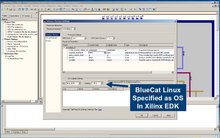FPGA softcore gains MMU, runs “full Linux”
Nov 13, 2007 — by LinuxDevices Staff — from the LinuxDevices Archive — 220 viewsXilinx has added the option of a memory management unit (MMU) to the royalty-free 32-bit soft-core processor it offers for its FPGA (field-programmable gate array) chips. The MMU allows the MicroBlaze v7 softcore to run complex OSes such as Linux, including LynuxWorks's commercially supported BlueCat-ME (MicroBlaze Edition) distribution.
Xilinx offers low-end “Spartan” and high-end “Virtex” FPGAs. Some models integrate PowerPC-based hard-cores, while others are meant to run soft-cores. The company's own MicroBlaze soft-core is included under a royalty-free license with Xilinx's $500 Embedded Development Kit (EDK), which supports application development on both hard- and soft-core Xilinx FPGAs.
Today's announcement of an optional MMU add-on for MicroBlaze came at the Tokyo Embedded Technology 2007 tradeshow. Xilinx's long-time Linux partner, LynuxWorks, was on hand to announce immediate support for MMU-ful Microblaze cores in its BlueCat-ME (MicroBlaze Edition) Linux distribution.
Based on a 2.6.13 kernel — with an upgrade to 2.6.23 in the wings — BlueCat-ME supports Linux development on Xilinx FPGAs with MMU-ful and MMU-less Microblaze soft-cores, as well as those with PowerPC hard-cores. The distribution includes GNU tools based on GCC 4.1.1. It is meant for use with Xilinx's EDK tools, rather than with LynuxWorks's own Eclipse-based Luminosity IDE, which does not yet support development on Xilinx FPGAs.



BlueCat-ME integrates with Xilinx's EDK
(Click any screenshot to enlarge)
Also present at the Tokyo launch was Impulse Accelerated Technologies (IAT), which offers “C-to-hardware” development tools designed to simplify FPGA hardware engineering. IAT's “Impulse C” tools are said to support standard software profiling and debugging tools for C application development, while helping programmers create hardware engines that support full, memory-managed Linux.
About the MicroBlaze soft-core
Xilinx describes the MicroBlaze soft-core as a 32-bit Harvard RISC architecture consisting of 32 general-purpose registers, an ALU (arithmetic logic unit), a shift unit, and two levels of interrupt. Additionally, this basic design can be enhanced with a barrel shifter, memory management/memory protection unit, floating-point unit (FPU), caches, exception handling, and debug logic capabilities.
The MicroBlaze soft-core itself was first released in 2001, and is now up to version 7. It supports “all of our FPGAs, past, present, and future, excluding CPLDs [complex programmable logic devices],” explained Tim Erjvec, director of marketing at Xilinx.
The MicroBlaze core has a footprint of about a thousand look-up tables, or “LUTs” as basic FPGA building blocks are referred to, Erjvec said. The new MMU option doubles that to 2,000 LUTs. Erjvec commented, “Our smallest FPGA probably can't fit [both MicroBlaze v7 and the MMU], but our midrange models can.”
Erjvec notes that 2,000 LUTs represent only about 10 percent of the resources available on Xilinx's flagship Virtex 16e chips, leaving plenty of room for customers to develop application-specific hardware.
The v7 MMU supports three operating levels under BlueCat Linux, according to LynuxWorks:
- MMU with privileged mode, memory protection, and virtual address translation
- MPU with privileged mode and memory protection
- Privileged mode only
Target markets include automotive electronic systems, wired and wireless communications, industrial, and military — all “areas where Linux is being widely adopted,” Xilinx said.
In some cases, performance may be better on systems without an MMU. However, an MMU simplifies software development considerably, and “many customers have requested an MMU,” Erjvec said.
Xilinx claims that implementing algorithms in hardware on FPGAs can yield two orders of magnitude better performance, compared to software running on a general-purpose processor. Additionally, the company says FPGAs are faster and less expensive to develop than ASICs (application-specific integrated circuits), in part because, “reprogramming the device is as simple as turning off power and turning it back on,” as Erjvec put it. Another touted benefit is “avoiding obsolescence,” since existing hardware can be reprogrammed to support new requirements, such as new codecs.
Erjvec explained that Xilinx's EDK tools can “stitch together” hardware designs with software, downloading it to a development target as a single bitstream. He explained, “In the past, customers picked an FPGA on basis of the number of logic gates. Now, it's top-down, starting with the OS, the bus, the interconnect. They build a system and then select what silicon to put it on.”
In addition to support for the new MMU, the v7 MicroBlaze soft-core adds:
- A 32-128 bit Processor Local Bus (PLB), a component of the IBM CoreConnect bus standard
- New DSP instructions
- “Xilinx Platform Studio” (XPS) tools within the EDK support concurrent hardware and software development
In a statement, LynuxWorks VP of Marketing Robert Day said, “By focusing on a combination of hard and soft processor and IP cores, Xilinx delivers a no-compromise solution with flexibility and performance required in a wide range of markets including military and aerospace, industrial and consumer areas.”
Availability
Xilinx's EDK 9.2 release is available now, priced at $500. It includes a royalty free license for the MicroBlaze v7 softcore, and the XPS 9.2 tools suite, which in turn includes IP libraries for UARTs and memory controllers, drivers, documentation, and example applications.
Also available now is a MicroBlaze Development Kit, Spartan-3E 1600E FPGA edition, priced at $600. It includes a Spartan-3E 1600 FPGA development board.
BlueCat-ME is also available immediately. It is said to support Xilinx's complete line of FPGAs. Pricing was not disclosed.
This article was originally published on LinuxDevices.com and has been donated to the open source community by QuinStreet Inc. Please visit LinuxToday.com for up-to-date news and articles about Linux and open source.